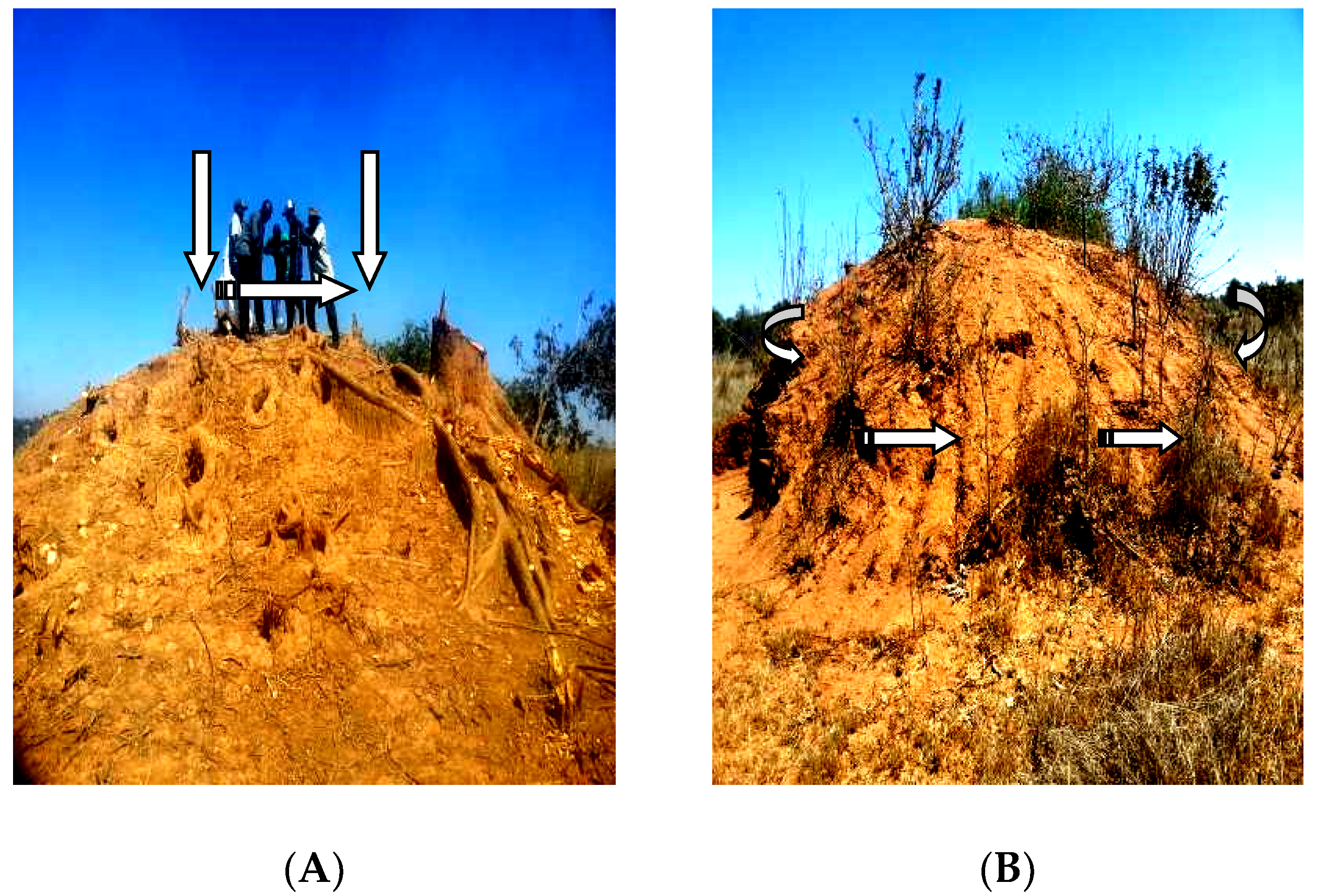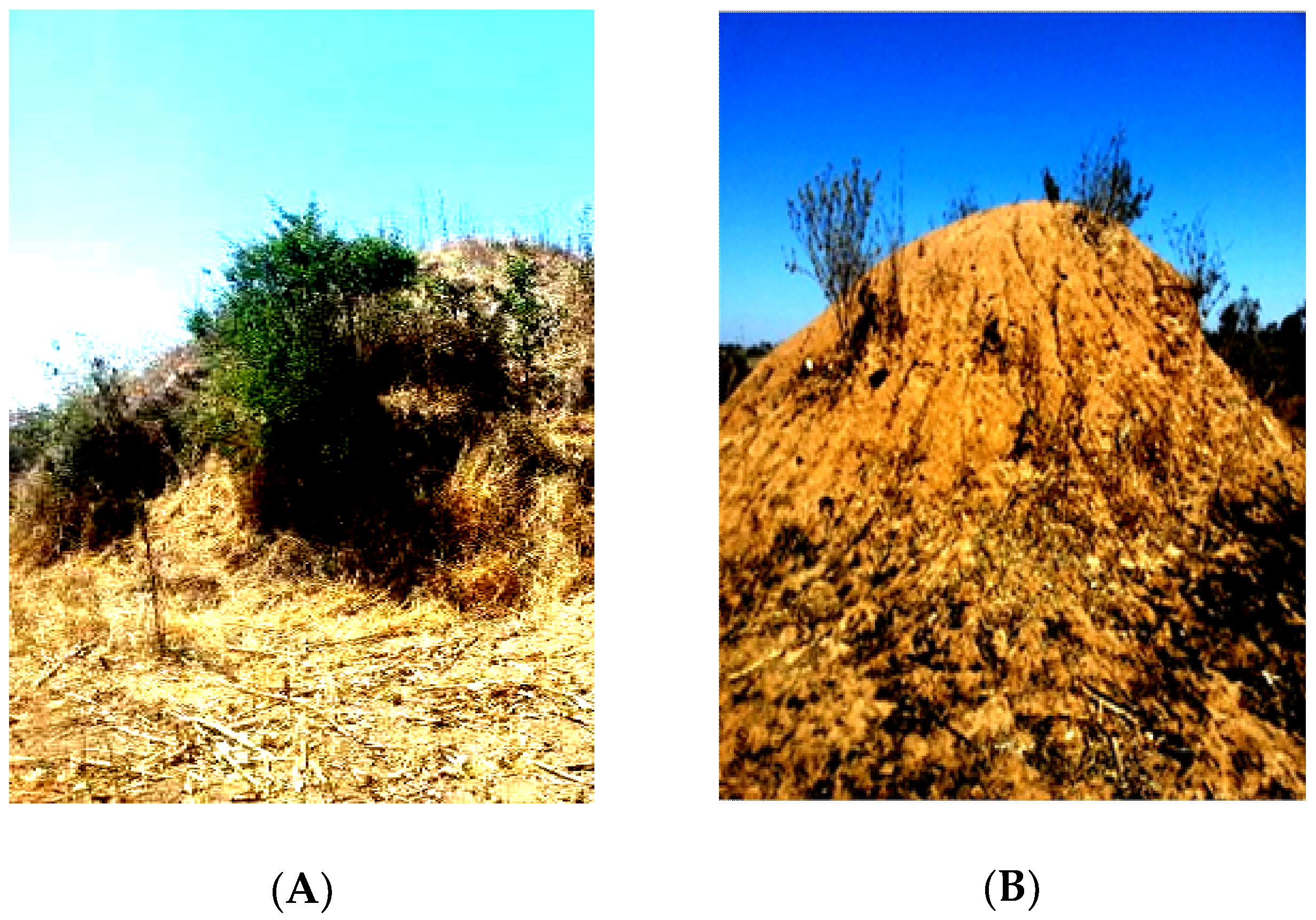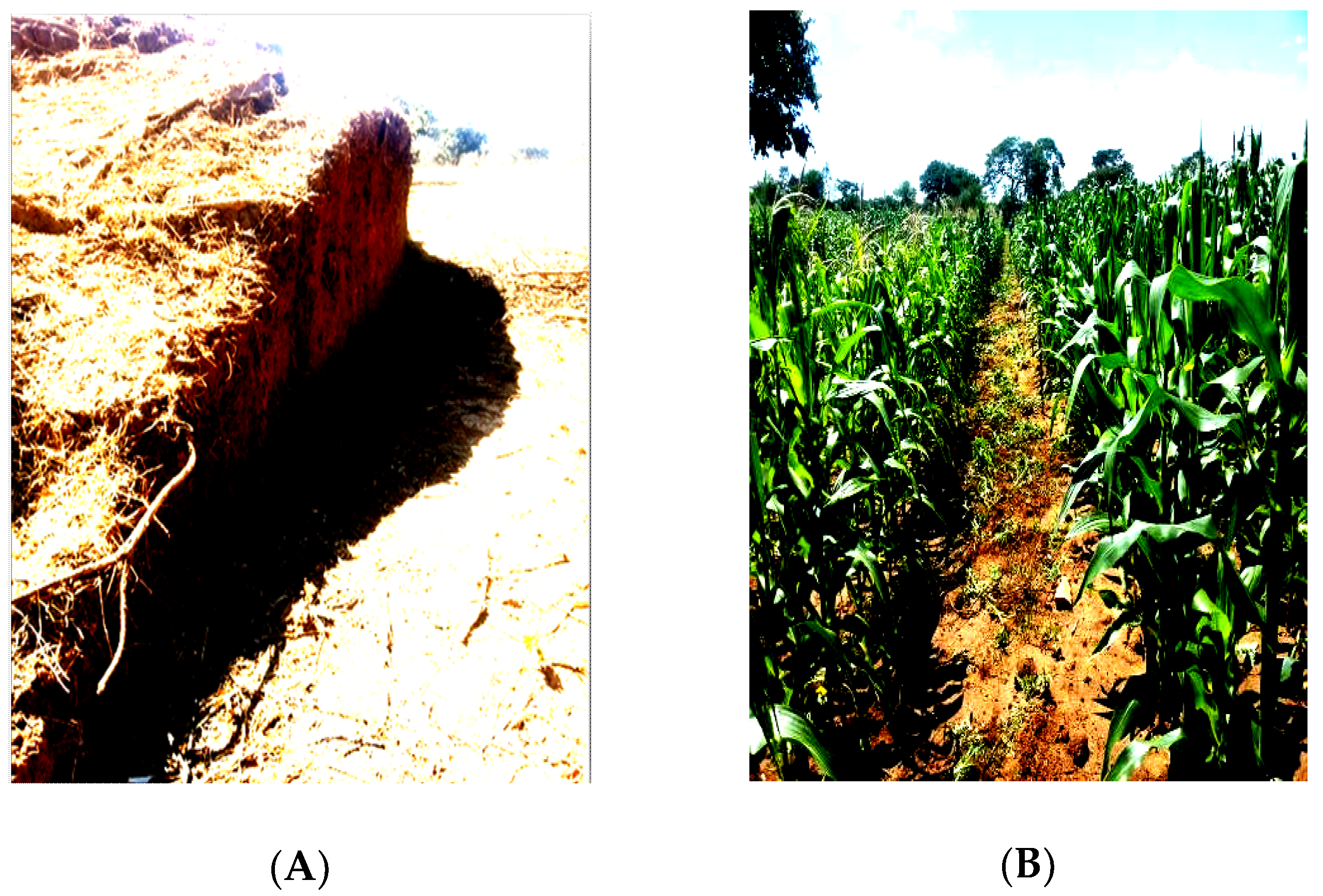Prospects of Using Termite Mound Soil Organic Amendment for Enhancing Soil Nutrition in Southern Africa
Abstract
1. Introduction
2. Materials and Methods
2.1. Study Site
2.2. Termite Mound Sampling Design
2.3. Laboratory Analytics
2.4. Statistical Analysis
3. Results
3.1. Soil pH
3.2. Total N
3.3. Available P
3.4. Exchangeable Mg and K
3.5. Exchangeable Ca
3.6. Organic Carbon (OC)
3.7. Cation Exchange Capacity (CEC)
3.8. Electrical Conductivity (EC)
3.9. Available Cu, Fe and Zn
3.10. Soil Texture
3.11. Relationship between O.C and N, P, K, Cu, Zn and Fe
4. Discussion
5. Conclusions
Author Contributions
Funding
Acknowledgments
Conflicts of Interest
References
- FAO. FAO Status of the World’s Soil Resources (SWSR)—Technical Summary; Food and Agriculture Organization: Rome, Italy, 2015. [Google Scholar]
- Umar, B.B.; Aune, J.B.; Lungu, O.I. Effects of Faidherbia albida on the fertility of soil in smallholder conservation agriculture systems in eastern and sourhen Zambia. Afr. J. Agric. Res. 2013, 8, 173–183. [Google Scholar]
- Sileshi, G.W.; Nyeko, P.; Nkunika, P.O.Y.; Sekematte, B.M.; Akinnifesi, F.K.; Ajayi, O.C. Integrating Ethno-Ecological and Scientific Knowledge of Termites for Sustainable Termite Management and Human Welfare in Africa. Ecol. Soc. 2009, 14, 48. [Google Scholar] [CrossRef]
- Chapoto, A.; Chabala, L.M.; Lungu, O.N. Long History of Low Productivity in Zambia: Is it Time to Do Away With Blanket Recommendations; IAPRI: Lusaka, Zambia, 2016. [Google Scholar]
- Mtambanengwe, F.; Mapfumo, P. Combating food insecurity on sandy soils in Zimbabwe: The legume challenge. Symbiosis 2009, 48, 25–36. [Google Scholar] [CrossRef]
- Siame, J.A. Termite mounds as Fertilizer. LEISA 2005, 7, 27. [Google Scholar]
- Chisanga, K.; Mbega, E.; Ndakidemi, P. Socio-Economic Factors for Anthill Soil Utilization by Smallholder Farmers in Zambia. Sustainability 2019, 11, 4849. [Google Scholar] [CrossRef]
- Ruiz-Diez, B.; Fajardo, S.; Puertas-Mejia, M.A.; de Felipe Mdel, R.; Fernandez-Pascual, M. Stress tolerance, genetic analysis and symbiotic properties of root-nodulating bacteria isolated from Mediterranean leguminous shrubs in Central Spain. Arch. Microbiol. 2009, 191, 35–46. [Google Scholar] [CrossRef]
- Nziguheba, G.; Zingore, S.; Kihara, J.; Merckx, R.; Njoroge, S.; Otinga, A.; Vandamme, E.; Vanlauwe, B. Phosphorus in smallholder farming systems of sub-Saharan Africa: Implications for agricultural intensification. Nutr. Cycl. Agroecosystems 2016, 104, 321–340. [Google Scholar] [CrossRef]
- Otinga, A. Coping with Phosphorus Limitations: Allocation of P in Maize Based Cropping Systems in Western Kenya. Ph.D. Thesis, Katholieke Universiteit Leuven, Leuven, Belgium, 2012. [Google Scholar]
- Pérez-Fernández, M.; Míguez-Montero, Á.; Valentine, A. Phosphorus and Nitrogen Modulate Plant Performance in Shrubby Legumes from the Iberian Peninsula. Plants 2019, 8, 334. [Google Scholar] [CrossRef]
- Fageria, N.K.; Baligar, V.C. Properties of Termite Mound Soils and Responses of Rice and Bean to Nitrogen, Phosphorus, and Potassium Fertilization on such Soil. Commun. Soil Sci. Plant Anal. 2005, 35, 2097–2109. [Google Scholar] [CrossRef]
- Ministry of Tourism, Environment and Natural Resources. Zambia National Action Programme for Combating Desertification & Mitigating serious Effects of Drought in the Context of the United Nations Convention to Combat Desertification; Ministry of Science, Technology and Vocational Training: Lusaka, Zambia, 2002.
- Roland, B.; Oscar, S.; Christoph, N. Groundwater Resources for Southern Province, Brief Description of Physiography, Climate, Hydrology, Geology and Groundwater Systems of the Southern Province; Ministry of Energy and Water Development: Lusaka, Zambia, 2007.
- Nkem, J.N.; Lobry de Bruyn, L.A.; Grant, C.D.; Hulugalle, N.R. The impact of ant bioturbation and foraging activities on surrounding soil properties. Pedobiologia 2000, 44, 609–621. [Google Scholar] [CrossRef]
- Sarcinelli, T.S.; Shaefer, C.E.G.R.; Lynch, L.S.; Arato, H.D.; Viana, J.H.M.; Filho, M.R.A.; Goncalves, T.T. Chemical, physical and micromorphological properties of termite mounds and adjacent soils along a toposequence in Zona da Mata. Catena 2009, 76, 107–113. [Google Scholar] [CrossRef]
- VanReeuwijk, L.P. Procedure for Soil Analysis; International Soil Reference and Information Centre (ISRIC): Wageningen, The Netherlands, 1993. [Google Scholar]
- Walkley, A.; Black, I.A. An examination of the Degtjareff method for determining soil organic matter and a proposed modification of the chromic acid titration method. Soil Sci. 1934, 37, 29–38. [Google Scholar] [CrossRef]
- Page, A.L. Method of Soil Analysis, Part 2, Chemical and Microbiological Properties; American Society of Agronomy: Madison, WI, USA, 1982. [Google Scholar]
- Bray, R.H.; Kurtz, L.T. Determination of Total, Organic, and Available Forms of Phosphorus in Soils. Soil Sci. 1945, 59, 39–46. [Google Scholar] [CrossRef]
- VanReeuwijk, L.P. Procedures for Soil Analysis; International Soil Reference and Information Centre (ISRIC)–World Information: Wageningen, The Netherlands, 2006. [Google Scholar]
- Raina, J.N.; Sharma, J.C.; Sharma, I.P. Manual on Methods for Physical and Chemical Analysis of Soils; Department of Soil Science and Water Management, Dr Y.S Parmar University of Horticulture and Forestry: Nauni, India, 2007. [Google Scholar]
- Wang, T.; DeVogel, N. A revisit to two-way factorial ANOVA with mixed effects and interactions. Commun. Stat. Theory Methods 2019, 1–18. [Google Scholar] [CrossRef]
- Fairhurst, T. Handbook for Integrated Soil Fertility Management; Africa Soil Health Consortium: Nairobi, Kenya, 2012. [Google Scholar]
- Lindsay, W.L.; Cox, F.R. Micronutrient Soil Testing for the Tropics. In Micronutrients in Tropical Food Crop Production; Springer: Dordrecht, The Netherlands, 1985; pp. 169–200. [Google Scholar]
- Silanpaa, N. Micronutrients and Nutrient Status of Soils: A Global Study. In FAO Soil Bulletin; FAO: Rome, Italy, 1982. [Google Scholar]
- Mtambanengwe, F.; Mapfumo, P. Effects of organic resource quality on soil profile N dynamics and maize yields on sandy soils in Zimbabwe. Plant Soil 2006, 281, 173–191. [Google Scholar] [CrossRef]
- Ndakidemi, P.A.; Semoka, J.M.R. Soil Fertility Survey in Western Usambara Mountain, Northern Tanzania. Pedosphere 2006, 16, 237–244. [Google Scholar] [CrossRef]
- Wyngaard, N.; Cabrera, M.L.; Jarosch, K.A.; Bunemann, E.K. Phosphorous in the coarse soil fraction is related to soil organic phosphorous mineralization measured by isotopic dilution. Soil Biol. Biochem. 2016, 96, 107–118. [Google Scholar] [CrossRef]
- Hernandez, D.L.; Brossard, M.; Fardeau, J.C.; Lepage, M. Effect of different termite feeding groups on P sorption and P availability in African and South American savannas. Biol. Fertil. Soils 2006, 42, 207–214. [Google Scholar] [CrossRef]
- Yerokun, O. Chemical characteristics of phosphorous in some representative benchmark soils of Zambia. Geoderma 2008, 147, 63–68. [Google Scholar] [CrossRef]
- Kristiansen, S.M.; Amelung, W.; Zech, W. Phosphorous forms as affected by abandoned anthills (Formica polyctena Forster) in forest soils: Sequential extraction and liquid-state 31P-NMR spectroscopy. J. Plant Nutr. Soil Sci. 2001, 164, 49–55. [Google Scholar] [CrossRef]
- Minasny, B.; Mcbratney, A.B. Limited effect of organic matter on soil available water capacity:Limited effect of organic matter on soil water retention. Eur. J. Soil Sci. 2017, 69, 39–47. [Google Scholar]
- Mtangadura, T.J.; Mtambanengwe, F.; Nezomba, H.; Rurinda, J.; Mapfumo, P. Why organic resources and current fertilizer formulations in Southern Africa cannot sustain maize productivity: Evidence from a long-term experiment in Zimbabwe. PLoS ONE 2017, 12, e0182840. [Google Scholar] [CrossRef] [PubMed]
- Manzeke, G.M.; Mapfumo, P.; Mtambanengwe, F.; Chikowo, R.; Tendayi, T.; Cakmak, I. Soil fertility management effects on maize productivity and grain zinc content in smallholder farming systems of Zimbabwe. Plant Soil 2012, 361, 57–69. [Google Scholar] [CrossRef]
- Steffan, J.J.; Brevik, E.C.; Burgess, L.C.; Cerda, A. The effect of soil on human health: An overview. Eur. J. Soil Sci. 2017, 69, 159–171. [Google Scholar] [CrossRef] [PubMed]
- Haitao, W.; Donghui, W.; Xianguo, L.; Xiaomin, Y. Spatial distribution of ant mounds and effects on soil physical properties in wetland of the Sanjiang plain China. Acta Ecol. Sin. 2010, 30, 270–275. [Google Scholar]




| Nutrient Variable | Units of Measurement | Method Applied | References |
|---|---|---|---|
| pH (water) | pH | 1:1 (soil:H2O) | VanReeuwijk [17] |
| Organic Carbon | % | Walkley and Black | Walkley and Black [18] |
| Total N | % | Kjeldahl method | Page [19] |
| Available P | mg/kg | Bray II (molybdate blue) method, spectrophotometer | Bray and Kurtz [20] |
| Exchangeable K | mg/kg | 1 M NH4Cl, flame photometer | VanReeuwijk [21] |
| Exchangeable Ca | cmol/kg | 1 M NH4Cl, flame photometer | VanReeuwijk [21] |
| Exchangeable Mg, Cu, Fe, Zn | cmol/kg mg/kg | 1 M NH4Cl, atomic absorption spectrophotometer | VanReeuwijk [21] |
| Electrical Conductivity | Conductivity meter procedure | Raina et al. [22] | |
| Cation exchange capacity (CEC) | cmol/kg | Exchangeable K + Na + Ca + Mg + Al + H | Page [19] |
| Sand | % | Hydrometer method | VanReeuwijk [21] |
| Silt | % | Hydrometer method | VanReeuwijk [21] |
| Clay | % | Hydrometer method | VanReeuwijk [21] |
| District | pH | N (%) | P (mg kg−1) | K (cmol kg−1) | Ca (cmol kg−1) | Mg (cmol kg−1) | |
| Pemba | 6.59 ± 0.29a | 0.09 ± 0.01a | 6.12 ± 1.11a | 1.53 ± 0.31b | 44.91 ± 13.82a | 5.64 ± 1.36a | |
| Choma | 5.85 ± 0.30b | 0.05 ± 0.00b | 4.99 ± 0.72a | 74.47 ± 31.53a | 12.55 ± 2.93b | 1.01 ± 0.17b | |
| SCA | |||||||
| T | 6.53 ± 0.34b | 0.08 ± 0.01a | 8.04 ± 0.94b | 89.85 ± 46.32a | 52.58 ± 19.33a | 4.97 ± 1.61b | |
| B | 7.05 ± 0.19b | 0.07 ± 0.01a | 6.34 ± 1.24b | 23.91 ± 11.42ab | 30.53 ± 6.90ab | 4.57 ± 1.45b | |
| A | 5.08 ± 0.31a | 0.06 ± 0.01a | 2.30 ± 0.42a | 0.17 ± 0.05b | 3.09 ± 0.85b | 0.44 ± 0.09a | |
| Overall Treatment Effects–F statistics | |||||||
| District | 0.03 * | 0.00 * | 0.31 | 0.01 * | 0.01 * | 0.00 * | |
| SCA | 0.00 * | 0.26 | 0.00 * | 0.03 * | 0.01 * | 0.00 * | |
| District * SCA | 0.6 | 0.85 | 0.95 | 0.03 * | 0.03 * | 0.05 | |
| District | O.C (%) | CEC (cmol kg−1) | EC (µs cm−1) | Zn (mg kg−1) | Cu (mg kg−1) | Fe (mg kg−1) |
| Pemba | 1.01 ± 0.05a | 30.14 ± 7.67a | 841.65 ± 262.36a | 0.91 ± 0.19a | 0.81 ± 0.16a | 18.02 ± 2.37b |
| Choma | 1.07 ± 0.06a | 14.18 ± 2.92b | 90.81 ± 18.46b | 1.05 ± 0.16a | 0.66 ± 0.13a | 29.19 ± 1.18a |
| SCA | ||||||
| T | 1.31 ± 0.02a | 32.19 ± 8.92b | 439.99 ± 111.27ab | 1.45 ± 0.21b | 0.88 ± 0.20b | 25.84 ± 3.51b |
| B | 0.97 ± 0.04b | 30.09 ± 6.98b | 904.48 ± 391.56a | 1.12 ± 0.21b | 1.19 ± 0.08b | 17.63 ± 2.59a |
| A | 0.83 ± 0.04c | 4.21 ± 1.06a | 54.20 ± 11.96c | 0.36 ± 0.04a | 0.13 ± 0.05a | 27.35 ± 0.88b |
| Overall Treatment Effects—F Statistics | ||||||
| District | 0.12 | 0.03 * | 0.00 * | 0.44 | 0.31 | 0.00 * |
| SCA | 0.00 * | 0.00 * | 0.01 * | 0.00 * | 0.00 * | 0.00 * |
| District * SCA | 0.04 * | 0.25 | 0.01 * | 0.01 * | 0.93 | 0.03 * |
| District | Clay (%) | Silt (%) | Sand (%) |
| Pemba | 33.41 ± 6.27a | 7.66 ± 1.33a | 41.58 ± 7.04a |
| Choma | 27.30 ± 6.26a | 7.65 ± 1.16a | 45.85 ± 7.56a |
| SCA | |||
| T | 56.62 ± 7.06a | 5.49 ± 1.81b | 27.30 ± 6.15b |
| B | 29.98 ± 2.54b | 11.36 ± 1.25a | 41.34 ± 6.59ab |
| A | 4.47 ± 2.17c | 6.13 ± 0.69b | 62.51 ± 10.50a |
| Overall Treatment Effects—F Statistics | |||
| District | 0.26 | 0.99 | 0.67 |
| SCA | 0.00 * | 0.01 * | 0.02 * |
| District * SCA | 0.83 | 0.08 | 0.93 |
| Parameter | N | P | K | Cu | Zn | Fe |
|---|---|---|---|---|---|---|
| O.C | 0.34 * | 0.48 * | 0.45 * | 0.33ns | 0.51 * | 0.04ns |
© 2020 by the authors. Licensee MDPI, Basel, Switzerland. This article is an open access article distributed under the terms and conditions of the Creative Commons Attribution (CC BY) license (http://creativecommons.org/licenses/by/4.0/).
Share and Cite
Chisanga, K.; Mbega, E.R.; Ndakidemi, P.A. Prospects of Using Termite Mound Soil Organic Amendment for Enhancing Soil Nutrition in Southern Africa. Plants 2020, 9, 649. https://doi.org/10.3390/plants9050649
Chisanga K, Mbega ER, Ndakidemi PA. Prospects of Using Termite Mound Soil Organic Amendment for Enhancing Soil Nutrition in Southern Africa. Plants. 2020; 9(5):649. https://doi.org/10.3390/plants9050649
Chicago/Turabian StyleChisanga, Kafula, Ernest R. Mbega, and Patrick A. Ndakidemi. 2020. "Prospects of Using Termite Mound Soil Organic Amendment for Enhancing Soil Nutrition in Southern Africa" Plants 9, no. 5: 649. https://doi.org/10.3390/plants9050649
APA StyleChisanga, K., Mbega, E. R., & Ndakidemi, P. A. (2020). Prospects of Using Termite Mound Soil Organic Amendment for Enhancing Soil Nutrition in Southern Africa. Plants, 9(5), 649. https://doi.org/10.3390/plants9050649




